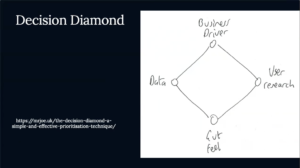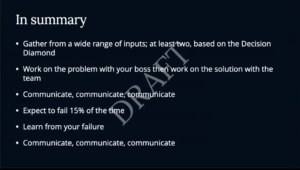For the latest Smart Cookies Breakfast Club, Joe Leech (Mr Joe – Product Management Coach, Author, Trainer & Keynote Speaker) shared his top tips on how to make successful product decisions.
Have you ever wondered how product teams in successful start-ups and large companies make decisions? What drives their choices? Do they always make the right choice?
Joe has a podcast where he interviews product leaders from around the world, including WordPress, Booking.com, YouTube, Monzo and Spotify asking them how they make the choices they do.
This talk took the learnings from the podcast and is all about what to build next and how to plan what to do in a week, in a month and further ahead. How successful product teams make good choices, and how your team can too.
You can watch the replay below or read on for a summary.

What types of decision are there?
Subtractive and Additive
When Joe interviewed Christian, head of research at YouTube, he spoke about two types of decisions: additive -building new things – and subtractive decisions – taking things away. Large organisations, such as Google, do this excellently. They’re really good at building new things but they’ve also taken a lot away from us over the years. The subtractive decisions are just as important.
Strategic Vs Tactical
The concept of strategic vs tactical decision making seems quite straightforward but it is not black & white which of these is which.
The Knot treat these as opportunites and initiatives – eg an opportunity would be expanding into Vietnam and nititave would be building a team there. Opportunities are the larger, broader strategic moves and the initiatives are the decisions needed to make that happen.
Some companies use ‘bets’ in their decision making, like Farewill and Spotify. Company bets are very similar to opportunities (eg – we’re going to launch in Nigeria, or we’re going to get into podcasting) – large scale big strategic decisions. Alongside those they have ‘functional bets’ which are things that have to happen in order for the larger company bet to succeed.
What’s great about the term ‘bet’ is that it doesn’t imply there is 100% certainty this is going to work. All of the bets are mini-experiments in themselves but together they form a strategy and a way of decision making.
Ideas and inputs
What are the inputs to decision making?
Classic inputs
Classic inputs are things like search data and insight. YouTube have huge amounts of data but alongside that run research on their users. They gather quantitative data and qualitative interviews and in-depth data to understand what people are thinking.
Data is helpful but it’s the company philosophy that defines the direction. Going back to the problem you’re trying to solve, checking back with what drives your company – the visions and the mission.
Looking at competitors is not necessarily a way to inform decisions. Keep an eye on them certainly, but don’t be defined by your competition – if you’re feature chasing you will always be behind. Big companies do not let competitors drive their business but focus on the problem they’re solving.
The Decision Diamond

Joe has started to map out the inputs that go toward making decisions into a diamond with four points:
- Data – quantitative information, metrics
- User research & insights – qualitative data
- Business drive – what’s pushing you forward in that market? What are your overarching business goals/vision/mission?
- Gut feel – what feels like the next best thing we should be doing?
Use this diamond to help you decide if you should move forward with a decision.
If it has two points of the diamond behind it (eg data and gut feel) then it’s a good idea.
Three points? Really do it.
If it has four points behind it, absolutely get on and do that right now, because everything is pushing you in that direction!
Weaknesses come in when the decision only meets one point on the decision diamond that’s met. The worst of all – going on gut feeling alone. That’s where decisions fail and the wrong choices are made.
3. People and the organisation
Execs in large organisations have been taught to have all the answers. Especially in the UK, we’ve had it drilled into us that if you’re a boss without the answers then you’re a failure. In larger organisations, this way of thinking only gets harder to battle.
To mitigate this, rather than the boss having the answers and giving the orders, the team are coming to the boss with a solution they’ve come up with for a problem they’ve noticed. The boss should understand what the team is working on and why they’re working on it.
When things go wrong, misalignment (rather than malice) is usually the reason. It all comes down to communication – the team think they’re doing this, the boss thinks they’re doing that and no one meets in the middle.
WordPress are tackling this by looking for ideas from anyone, anywhere in the company – rather than decisions trickling down from execs at the top, the ideas filter up from the team who are in touch with the users and the day-to-day problems.
Alignment is another obstacle, Make sure that product teams are aligned toward the same goal and the company vision/mission. Things tend to go really well when this is happening, but quite disastrously when it isn’t.
Making the decision
How can you optimise the process of the decision actually being made? Selena at The Knot talks about a feeling of fuzziness – uncertainty, of something not feeling quite right. As a leader you have to think about how you can cut through the fuzziness, and how to sense it in the first place.
It’s also important to look at why things are not done, and decisions aren’t taken forward. Maybe it doesn’t align with the strategy. Perhaps you need to hire an extra 20 people to run the idea – this doesn’t mean the idea wasn’t great!
At WordPress they have a decision counsel made up of Tech, Business, Design and Product. They make the high level ‘bets’ about where the business is going. However your business prioritises ideas, your whole organisation needs to be behind that prioritisation framework.
The Execution
Once you’re 80% ready – go. This is where larger organisations fail – they look to have 98-100% certainty something is going to work. Startups go in much lower at wound 20-40% readiness.
It’s vital you set your team up for and expect a chance of failure. Harpal Singh says that 10-15% of new features fail – but these provide just as valuable learning opportunities as decisions that succeed. Go back to the drawing board, analyse feedback and adapt.
Jeff Gothelf sees decision making as a continuous two-way dialogue with the market. Do you like this? Yes? Great. No? Ok – let’s try something else.
Selena at The Knot talks about the best thing that can happen when you’ve launched a new feature – even if it initially seems like a failure – is when people react with outrage about how much better it could be. That tells you you’ve got product market fit and you have valuable feedback on how to build on it.
All of these combine to make…
The Secret Sauce

- Gather from a wide range of inputs; at least two, based on the Decision Diamond
- Work on the problem with your boss then work on the solution with the team
- Communicate, communicate communicate!
- Expect to fail 15% of the time
- Learn from your failure
- Communicate communicate communicate
And that should help you and your product team make better decisions! A big thank you to Joe for a great session – you can find out more about him on his website, subscribe to his podcast via Apple or Spotify and connect with him on LinkedIn.
Why not join us at our next Smart Cookies Breakfast Club session? Bitesize chunks of top quality content to help you take your business to the next level. All before 9 am!